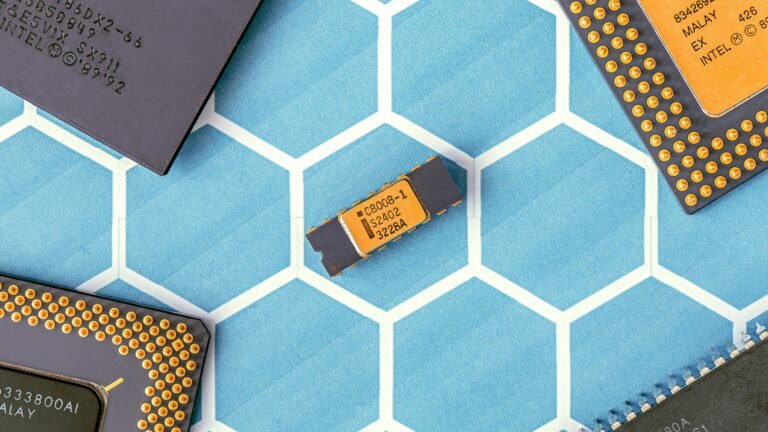
Squarepusher: The Revolutionary Force Behind Drill ‘n’ Bass and Electronic Music Innovation
Squarepusher stands as one of the most innovative and influential figures in electronic music, representing the audacious spirit of the mid-1990s UK scene that fundamentally transformed how electronic composition could be conceived, performed, and experienced. The project of Thomas Russell Jenkinson (born January 17, 1975), Squarepusher has spent nearly three decades pushing the boundaries between jazz virtuosity, breakbeat manipulation, and technological experimentation, creating a body of work that spans drill ‘n’ bass, IDM, acid techno, jazz fusion, and electroacoustic music.
Early Life and Musical Formation
Born and raised in Chelmsford, Essex, Jenkinson’s musical education began in an ecclesiastical environment through his attendance at a school affiliated with Chelmsford Cathedral, where exposure to organ music provided his first encounter with complex harmonic structures. This early classical foundation would prove crucial to his later sophisticated approach to electronic composition.
His formative musical experience came at King Edward VI Grammar School in Chelmsford, where he witnessed guitarist Guthrie Govan performing in the inter-house music competition—a moment that crystallized his understanding of instrumental virtuosity. Jenkinson developed a lasting friendship with Govan, who would become a respected session musician, demonstrating the high level of musical sophistication within Jenkinson’s early circle.
At age 12, Jenkinson joined his first band, a Metallica-influenced thrash metal group consisting of several school pupils. Over subsequent years, he played bass guitar in various local bands throughout East Anglia and London, gaining extensive experience in live performance and studio recording that would inform his later approach to integrating acoustic instruments with electronic production.
The crucial transition came in 1991 when Jenkinson became interested in house music, hardcore, acid house, and techno. His citation of hearing “LFO” by LFO as an early influence demonstrates his attraction to the more experimental edges of electronic music rather than purely commercial dance music.
The Spymania Years and Early Innovation
Jenkinson’s entry into electronic music production began with the Conumber E:P in 1995 on Spymania, marking the debut of what would become known as drill ‘n’ bass. These early tracks, initially “disregarded as misplaced perversions of jungle’s more obvious compositional principles,” found ready acceptance among fans of “post-acid house experimental listening music”.
The Spymania releases, including “Alroy Road Tracks” under the moniker Duke Of Haringey, established Jenkinson’s approach of combining “post-bop, avant-garde and progressive jazz with breakbeat techno, making heavy use of the Amen break“. These tracks would later be compiled onto the album “Burningn’n Tree,” demonstrating the coherent artistic vision underlying his early experimental releases.
Critics initially struggled to categorize this music, with 23-year-old Tom Jenkinson creating work that “defiantly resisted categorisation right from the off”. His music was characterized as “complex, fluid, restlessly inventive, constantly striving to strike the balance between energy and innovation and fuelled by the desire to achieve nothing less than the best”.
“Feed Me Weird Things” (1996): The Rephlex Debut
The breakthrough came with “Feed Me Weird Things,” released through Aphex Twin‘s Rephlex Records in June 1996. This debut album under the Squarepusher name represented where “the Squarepusher really started to stretch out harnessing the energetic as fuck production normally associated with hardcore and early drum ‘n’ bass with Tom’s more jazz focused musicality”.
The album’s success proved “there’s a large audience out there hungry for a curious and uncompromised slant on music,” establishing Jenkinson within the international electronic music community. Richard James (Aphex Twin) and the Rephlex camp’s support provided crucial validation for Jenkinson’s experimental approach, positioning him within the broader IDM movement.
“Feed Me Weird Things” was recorded around the same time as “Stereotype” but represented a more refined artistic statement that would define Squarepusher’s signature sound. The album demonstrated Jenkinson’s ability to integrate “impossible-to-dance-to rhythms” with genuine melodic beauty, creating what critics would later recognize as a foundational work of the drill ‘n’ bass genre.
“Hard Normal Daddy” (1997): The Warp Records Masterpiece
Jenkinson’s move to Warp Records resulted in “Hard Normal Daddy,” released April 28, 1997, and widely considered his masterpiece. The album marked his first studio release for Warp after being courted by multiple labels including Ninja Tune, Rephlex Records, and R&S Records.
Critics characterized the album as representing an early example of the drill ‘n’ bass subgenre, described as a version of drum ‘n’ bass that warped “old midtempo beats and breaks into a frenzied, experimental potpourri of low-attention-span electronic music”. Baltimore Sun critic J. D. Considine described it as jazz fusion influenced, noting its “lyrical, complicated keyboard riffs, dense, churning beats, nimble, melodic fretless bass—add in a saxophone, and you’d have the drum ‘n’ bass equivalent of Weather Report“.
However, Jenkinson stated that his music on “Hard Normal Daddy” was not influenced by jazz fusion but by funk-oriented music such as Herbie Hancock‘s “Death Wish” soundtrack and 1970s television themes from police and detective shows. This clarification demonstrates his eclectic approach to sourcing inspiration from popular culture rather than academic jazz traditions.
The album featured twelve tracks including “Coopers World,” “Beep Street,” “Vic Acid,” and “Fat Controller,” each demonstrating different aspects of Jenkinson’s compositional range. “Hard Normal Daddy” was listed as one of the best albums of 1997 by NME and The Wire, with Stylus Magazine referring to it in 2003 as Squarepusher’s “masterpiece” and Pitchfork ranking it in 2017 as one of the greatest IDM albums of all time.
Live Performance and DJ Innovation
Squarepusher’s live performances became legendary events that redefined electronic music presentation. Acclaimed gigs at Glastonbury, Mount Fuji Rock festival in Japan, and Belgium’s Ten Days of Techno featured Jenkinson improvising live bass around structures created with his “boxes and tapes”. These performances were described as “chaotic affairs” but “shot through with a purposiveness absent in most lacklustre electronic acts claiming to have gone ‘live'”.
His DJ sets became equally renowned for their unpredictability, “known to include furious drum’n’bass, hardcore, tequila, even the work of the brothers Bros (I Owe You Nothing?)” and were credited with shaking “dancefloors to an incendiary state”. This eclectic approach demonstrated Jenkinson’s refusal to be confined within electronic music orthodoxy.
The integration of live bass performance with electronic programming distinguished Squarepusher from purely laptop-based electronic acts. Jenkinson’s virtuoso bass playing, including “melodic fretless playing, high-speed slap bass and intricate chordal work,” became a signature element that connected his work to jazz traditions while maintaining electronic music’s experimental edge.
“Music Is Rotted One Note” (1998) and Technical Evolution
For “Music Is Rotted One Note” (1998), Jenkinson made a crucial technical decision to abandon sampled drum breaks in favor of programming his own beats. This shift marked his movement toward greater control over every aspect of his compositions, allowing for the development of increasingly complex rhythmic structures that couldn’t be achieved through sample manipulation alone.
The album represented Jenkinson’s philosophy of “trying to shut myself out of the mediocrity that surrounds us all,” positioning his work as conscious resistance to commercial electronic music trends. This artistic stance would continue to define Squarepusher’s approach throughout his career, prioritizing innovation over accessibility.
“Go Plastic” (2001) and the New Millennium
“Go Plastic” (2001) demonstrated Jenkinson’s continued evolution as both programmer and performer, featuring increasingly sophisticated integration of live instrumentation with electronic manipulation. The album marked a period of peak creativity where Squarepusher balanced complex programming with melodic accessibility, creating music that was both intellectually challenging and emotionally engaging.
This period established Squarepusher as one of Warp Records‘ most important artists, alongside Aphex Twin and Autechre, representing the label’s commitment to pushing electronic music into previously unexplored territories.
“Ultravisitor” (2004): Live Recording Innovation
“Ultravisitor,” released March 8, 2004, represented perhaps Jenkinson’s most ambitious artistic statement. The album incorporated “many of the various musical styles exhibited by Jenkinson on his previous albums, including drum and bass, acid techno, jazz fusion, and electronic noise,” with several tracks featuring “layered, modulated, or filtered bass guitar”.
In a groundbreaking approach, most tracks on “Ultravisitor” were recorded from shows in the UK, US, and Canada. Jenkinson explained: “The point of using live versions of the tracks is that they show stupid people that, though their own stubbornness prevents them from being able to engage with my music, they hear other people cheering in the background, and realise that although this music is obscure, it cannot be totally inaccessible because other people like it”.
The most complex composition, “50 Cycles,” took over a month to complete, representing “unprecedentedly long” completion times for several pieces on the album. Jenkinson described “Ultravisitor” as his “spectacle of beauty and of terror. It is unknowable, and will never be understood by anybody, least of all its creator”.
20th Anniversary Remaster and Contemporary Recognition
In September 2024, Warp Records announced a remastered reissue of “Ultravisitor” to coincide with its 20th anniversary. Never entirely satisfied with the sound of the original release, Jenkinson “relished the opportunity to bring out fresh dynamics and detail in the tracks,” with remastering by Jason Mitchell at Loud Mastering.
The 20th anniversary edition includes a bonus album, “Venus No.17 Maximised,” compiled from tracks originally released as part of promotional materials. The accompanying booklet contains “photographs, posters and recording documentation from Tom’s archive,” providing comprehensive documentation of the album’s creation process.
Limited to 5,000 copies worldwide, the reissue demonstrates continued interest in Squarepusher’s work twenty years after its original release. Rick Rubin‘s endorsement “This sounds great” and testimonials from other prominent musicians highlight the album’s enduring influence.
“Be Up A Hello” (2020): Recovery and Return
After a five-year hiatus from releasing music under the Squarepusher alias, Jenkinson returned with “Be Up A Hello” in January 2020. The album emerged from challenging personal circumstances, including a broken wrist sustained from slipping on ice in Norway in January 2018.
The injury was particularly devastating for Jenkinson as a guitarist: “The doctor told me I could lose feeling in my fingers. It was pretty hair-raising. Playing instruments is completely central to my work. I didn’t know at that point whether I’d be able to play again”. The bone injury involved “a nerve running through it,” creating potential for permanent damage to his instrumental abilities.
Forced to abandon his bass guitars, Jenkinson turned to vintage technology for the album’s creation, using analogue synthesizers, vintage effects units, and a Commodore VIC-20 rather than the custom software he had developed over fifteen years. This return to 1990s equipment represented both practical necessity and artistic choice, reconnecting him with the tools that had shaped his early work.
The album also served as tribute to Chris Marshall, a childhood friend from Chelmsford who had died the previous year. Marshall had been crucial to Jenkinson’s early clubbing experiences, driving their group in his father’s Ford Escort to parties where they would “park up in an old barn, get some acoustic reinforcements and turn up the car stereo”. The album title “Be Up A Hello” derived from an in-joke from their teenage social circle.
Critics noted that “Be Up A Hello” represented “refreshingly direct” music “after several records of heady composition and high-concept music”. The album received “generally favourable reviews,” with a Metacritic score of 76/100 based on professional critics.
“Dostrotime” (2024) and “Stereotype” (2025): Archaeological Discoveries
“Dostrotime,” released March 1, 2024, marked Jenkinson’s latest exploration of electronic music possibilities. The album continued his pattern of technical innovation while maintaining the complex rhythmic structures and melodic sophistication that have defined his work for three decades.
Perhaps most significantly, October 24, 2025 saw the release of “Stereotype,” described as “the lost Squarepusher album”. Originally self-released under the artist name ‘Stereotype’ in 1994, this collection represents “the earliest known full-length release” by Jenkinson, predating even “Feed Me Weird Things”.
The album contains “an hour of raw, dancefloor-focused early Squarepusher productions, fuelled by pirate radio and rave” that contrasts sharply with the “rhythmically complex music that followed it” in his discography. The six tracks demonstrate Jenkinson’s connection to “dance floor-ready music heard on pirate radio and at raves,” revealing the foundational influences that would later be transformed through his innovative production techniques.
The 2025 reissue marks “the first time that the album has been made available on CD and digitally,” while the vinyl release has been cut as a 2xLP—the original vinyl edition crammed almost an hour of music onto one single 12-inch record. This archaeological recovery provides crucial insight into Jenkinson’s artistic development and the underground UK electronic scene of the early 1990s.
Technical Innovation and Equipment Philosophy
Throughout his career, Jenkinson has maintained a sophisticated relationship with technology that balances cutting-edge innovation with respect for analog traditions. His development of custom software over fifteen years, used on albums like “Ufabulum” (2012) and “Damogen Furies” (2015), demonstrated his commitment to creating tools specifically suited to his compositional vision.
However, his return to vintage equipment for “Be Up A Hello” revealed his understanding that different tools enable different creative possibilities. His use of Eventide processing units and other professional audio equipment has been studied by other producers seeking to understand his signature sound processing techniques.
Jenkinson’s approach to bass guitar remains central to his identity, incorporating “melodic fretless playing, high-speed slap bass and intricate chordal work” that connects his electronic work to jazz traditions. Even when physical injury prevented him from playing, he continued to explore ways to integrate bass frequencies and techniques into his electronic compositions.
Cultural Impact and Legacy
Squarepusher‘s influence extends far beyond his immediate contemporaries, helping to establish drill ‘n’ bass as a legitimate subgenre and inspiring countless electronic musicians to explore the integration of live instrumentation with programmed elements. His work alongside Aphex Twin, Luke Vibert, and μ-Ziq helped define the experimental edge of 1990s electronic music.
His integration with Warp Records positioned him within the label’s roster of groundbreaking artists, contributing to Warp’s reputation as the home of the most innovative electronic music. Albums like “Hard Normal Daddy” and “Ultravisitor” continue to be cited as foundational works within IDM and experimental electronic music.
The drill ‘n’ bass movement that Squarepusher helped pioneer would eventually contribute to the development of breakcore, demonstrating the ongoing evolution of electronic music subgenres. Artists like Venetian Snares, Kid606, and numerous others have acknowledged Squarepusher’s influence on their own experimental approaches.
Contemporary Relevance and Future Directions
As of 2025, Squarepusher continues to evolve as both performer and composer, with recent releases demonstrating his ability to revisit earlier approaches while incorporating decades of accumulated experience. The “Stereotype” reissue provides fans and scholars with crucial historical context for understanding his artistic development, while “Dostrotime” shows his continued commitment to pushing electronic music into new territories.
His influence on contemporary electronic music producers remains strong, with his techniques for integrating live instrumentation with electronic programming continuing to inspire new approaches to hybrid composition. His commitment to technical innovation, combined with respect for musical tradition, provides a model for artists seeking to balance experimental ambition with emotional accessibility.
Jenkinson’s approach to live performance—combining programmed elements with real-time improvisation has become increasingly relevant as electronic music artists seek ways to create authentic live experiences. His legendary performances continue to set standards for what electronic music performance can achieve when programming serves musical expression rather than substituting for it.
Through nearly three decades of recorded output, Squarepusher has established himself as one of electronic music’s most essential and enduring artists. His work demonstrates that electronic music can be simultaneously intellectually challenging and emotionally engaging, technically sophisticated and viscerally exciting. From the early drill ‘n’ bass innovations through the mature statements of “Ultravisitor” and “Be Up A Hello,” Jenkinson has consistently pushed electronic music toward greater complexity, beauty, and human expression.
His integration of jazz virtuosity with electronic innovation, his commitment to live performance authenticity, and his ongoing exploration of new technological possibilities ensure that Squarepusher remains not just historically significant but actively relevant to electronic music’s continued evolution. In an era where electronic music faces questions about authenticity and human expression, Jenkinson’s work provides compelling evidence that technology can serve rather than replace genuine musical communication.








